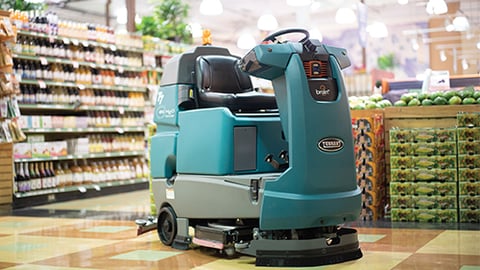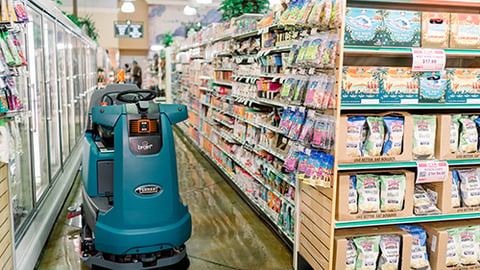The Benefits of Hygienic Flooring
Safeguarding the health and well-being of employees and shoppers in grocery stores, supermarkets and other retail establishments has never been more important than it is today. Yet it’s also becoming an even more complex task — as sanitation requirements increase, so do customer expectations. Not only is minimizing contamination incidents and spread a priority for earning the trust of shoppers, it’s also a growing expectation from local governments for retailers to help protect against outbreaks.
A Shift in Focus in the Grocery Industry
While food may become contaminated at any point in the supply chain, from where it’s manufactured to where it’s processed and packaged, few areas within any building present as high a risk of infection and pathogen transmission as the floor. Gravity causes contaminants to end up on facility floor surfaces, where they can be easily spread by people and equipment alike. Therefore, it’s important to consider hygienic flooring properties to help grocers reduce the accumulation of unwanted microbes, mold, dust, fungi and more.
Given today’s current climate, it’s critical for grocers to take their floors seriously when it comes to addressing hygiene practices in their establishments.
The Properties of Hygienic Floors
To demonstrate to shoppers and employees that you take store hygiene and cleanliness seriously, an emphasis on good surface decontamination is imperative. USDA-compliant flooring with specific hygienic properties can go a long way toward supporting these efforts. These properties include:
- Monolithic, Virtually Seamless Surfaces: Traditional flooring in grocery stores often falls into the tile or vinyl flooring categories. While these can be useful in some settings, in food operations, these types of floors open the opportunity for infection to spread, as pathogenic microbes, mold and other contaminants can easily hide in cracks and crevices. A better flooring option is one that minimizes surface breaches. Poured flooring, such as a commercial-grade epoxy floor, is a good option for lowering the risk of pathogen spread.
- Improving Cleanability: Attention to the 90-degree angles where the wall and floor meet is also critical. These hard-to-reach angles and joints are nearly impossible to disinfect. Plastic or rubber glue-on coves can make matters worse, providing an open invitation for mold and pathogenic microbes to become entrapped underneath. In contrast, flooring that incorporates seamless floor-to-wall coving eliminates the 90-degree angles, thus helping to minimize microbial spread within the room. A rounded (radial) integral cove base also enables custodial staff to quickly and more thoroughly clean and sanitize.
- Antibacterial Properties: Unlike many standard flooring options, industrial flooring systems such as epoxies offer the option of incorporating antimicrobial additives to the floor material, which may assist in fighting the spread of harmful mold and other microbes.
- Chemical Resistance: For flooring to withstand today’s intensified facility hygiene and cleaning protocols, the surfaces must have the ability to undergo repeated exposure to harsh disinfecting chemicals and rigorous deep cleanings. Additionally, in food prep and cooking departments, freezers, coolers and even store aisleways, spills from various liquids, hot oil, fats and blood can easily end up on floors. Depending on location and usage, these substances can quickly degrade many types of standard commercial flooring, which is often not designed with chemical resistance in mind. The surfaces of inferior flooring can rapidly become compromised, thus allowing pathogenic contaminants to enter and remain hidden within the floor matrix itself.
- Floor Pitch and Drainage: For locations where floors get regularly washed down, such as butcher departments, prep kitchens, walk-in-coolers and produce storage, correctly pitched floors and drainage systems are a must. Water puddles can contribute to microbial growth and are also a dangerous slip hazard. USDA-compliant flooring, such as highly moisture-tolerant urethane mortar systems (also called “cementitious urethane”) can be used to correct floor slope, enabling proper drainage of effluent, without puddling.
Understanding the potential presence of contaminants in every area of your food operation is the first step toward meeting today’s enhanced sanitation standards. Having optimal flooring in place can go a long way toward supporting your facility’s contamination control efforts, increasing their efficiency and efficacy. Well-selected and properly installed USDA-compliant floor systems can help mitigate the presence of pathogens – and demonstrate to your customers and employees that their well-being is a priority.
The implicit message that a clean, bright and comfortable environment sends to customers and employees can have a tremendous impact on loyalty. The right USDA-compliant supermarket flooring solutions, coupled with proper facility sanitation and hygiene procedures, can help create optimal experiences that ensure safety for shoppers and workers alike.







